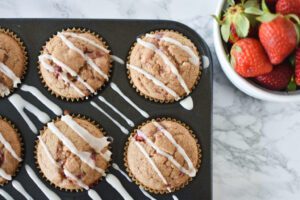Tips for Plant-Based and Allergen-Free Baking


Baking brings joy to the kitchen — whether you’re the one doing the baking or the eating. But baking can be tricky, especially when you’re making treats for people with different dietary requirements.
Researchers estimate that 32 million Americans have food allergies, including 5.6 million children under age 18. And many of the major food allergens, like eggs, wheat, milk, and nuts, are integral to the baking process.
So how should the home cook go about creating baked goods if they want to avoid animal products as well as major food allergens? Thankfully, you don’t need to come up with an answer all on your own. We spoke with Chef Patrick, the head chef at Abe’s Vegan Muffins, a leading brand of plant-based and allergen-free muffins and cakes, to learn more about baking with nut-free, egg-free, and dairy-free ingredients.
This Monday, see how you can use Chef Patrick’s insights to make baked goods for all types of eaters.
Learn the Common Allergens
Congress passed the Food Allergen Labeling and Consumer Protection Act of 2004 (FALCPA) to identify and standardize the major food allergens. The list includes milk, eggs, fish, shellfish, tree nuts, peanuts, wheat, and soybean. Once you become familiar with the major food allergens, you can learn how they can be replaced.
Don’t Be Afraid of Wheat-Free Flour
Gluten-free baked goods have a bad reputation for their notoriously grainy texture, but Chef Patrick says that you can use ancient grains like buckwheat, millet, amaranth, teff, or a combination of different varieties to fit your personal baking needs.
Make Your Own Plant-Based Eggs
Chicken eggs provide bakery items with structure, color, and taste, but you can create your own plant-based eggs to perform similar functions. Chef Patrick says that swapping a ¼ cup of apple sauce can do the trick for some baked goods, or you can mix a tablespoon of flax with 3 tablespoons of water to replace one egg.
Use the Right Milk
Each non-dairy milk has its own unique property and flavor. For muffins, Chef Patrick recommends using rice milk in place of cow’s milk because its neutral taste allows the primary flavor of the muffin to shine. Oat milk is another nut-free/dairy-free option that works well but may affect the color of the final product.
Try Adding Extra Veggies
Although baked goods are typically sweet treats, you can make them a bit better for you by adding more plant-based ingredients. The first step is to use good quality, organic, non-GMO ingredients when possible. You can also add some shredded veggies like carrots, sweet potatoes, and zucchini for some extra flavor and texture.
